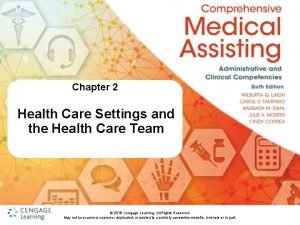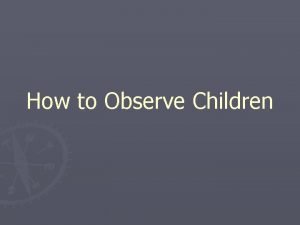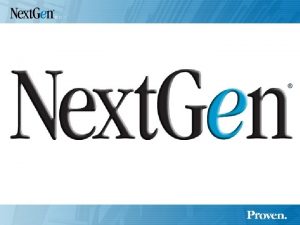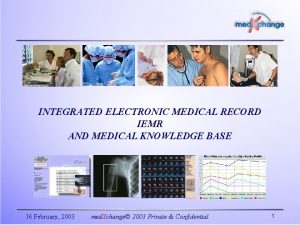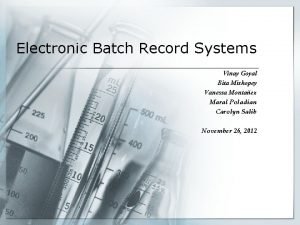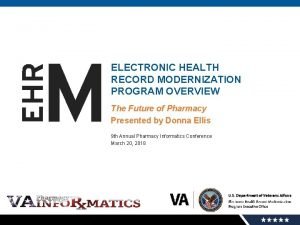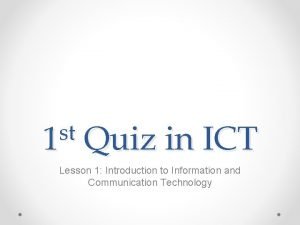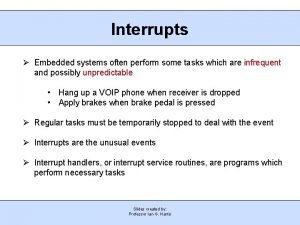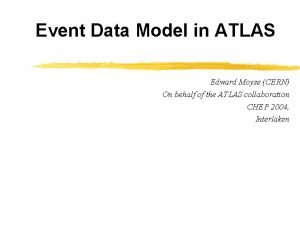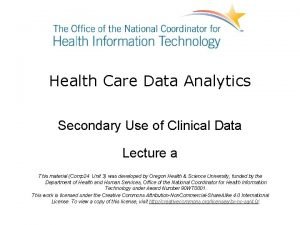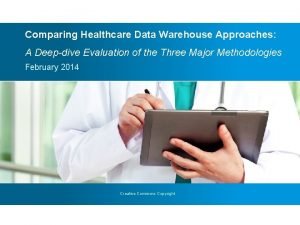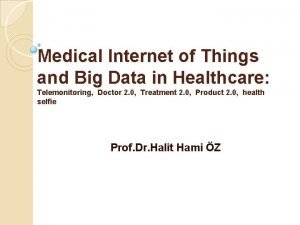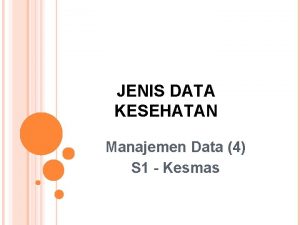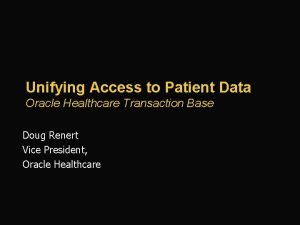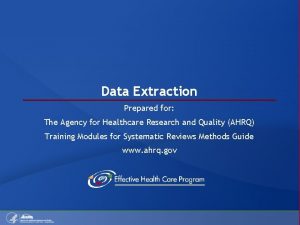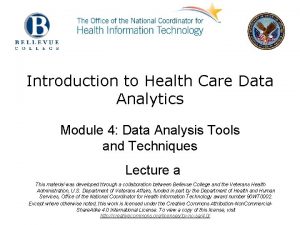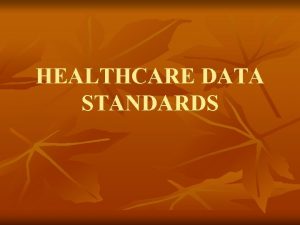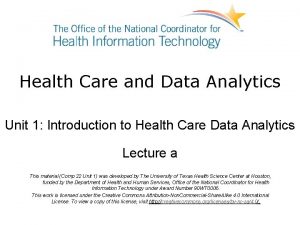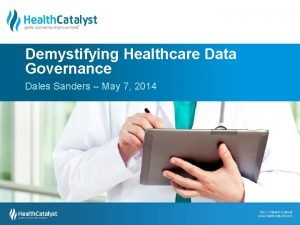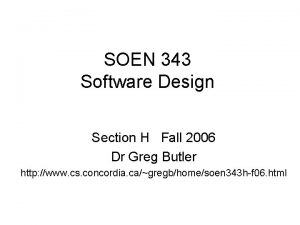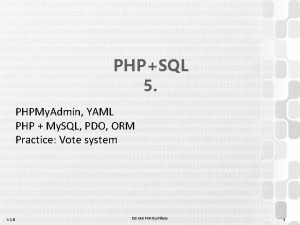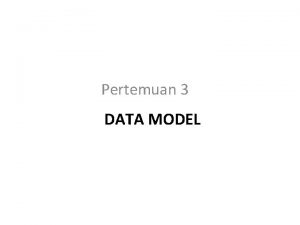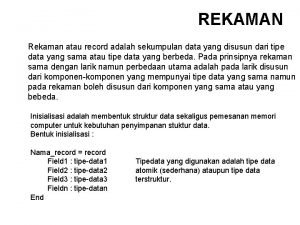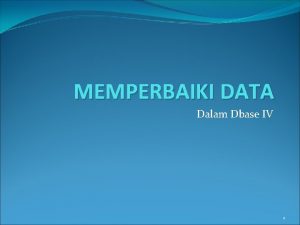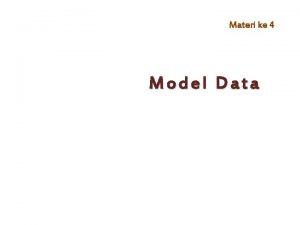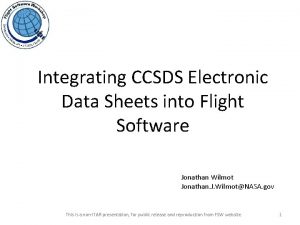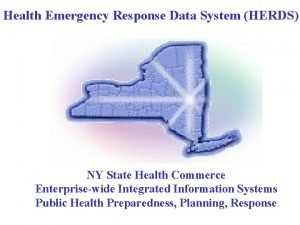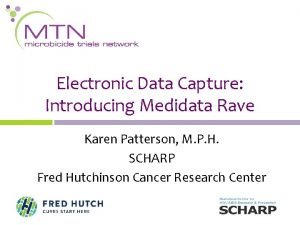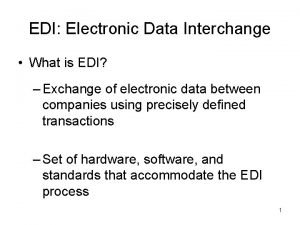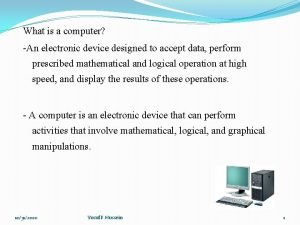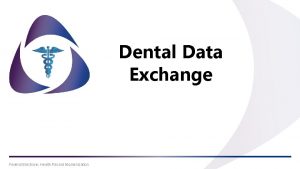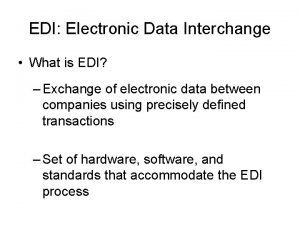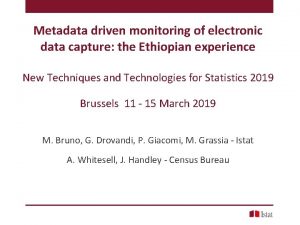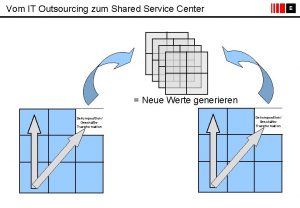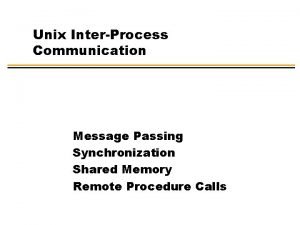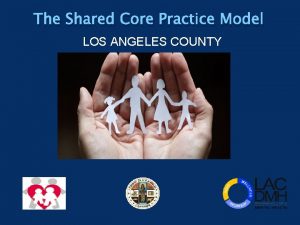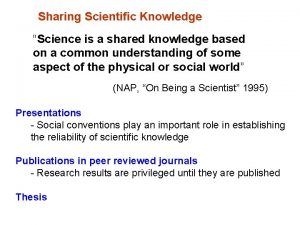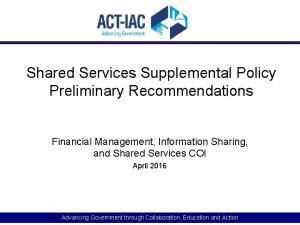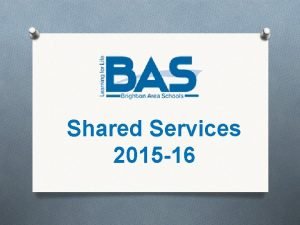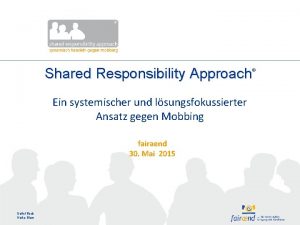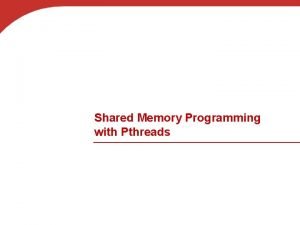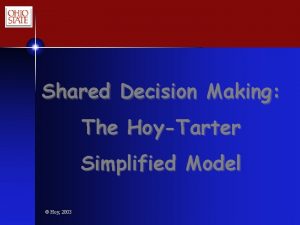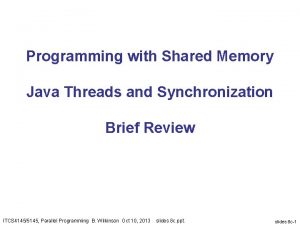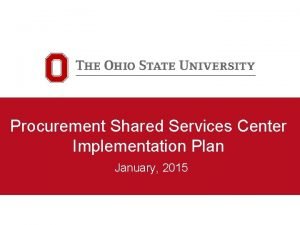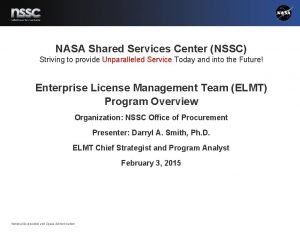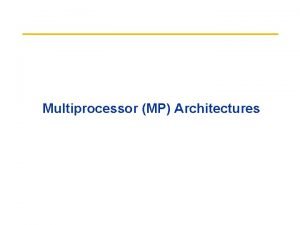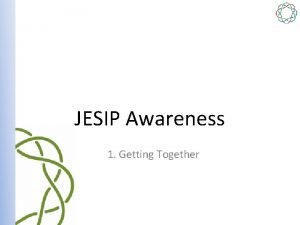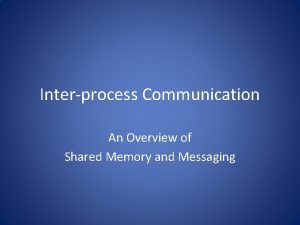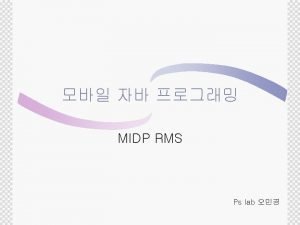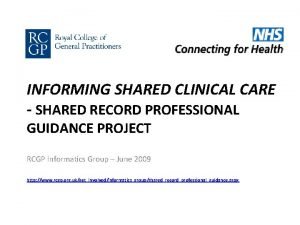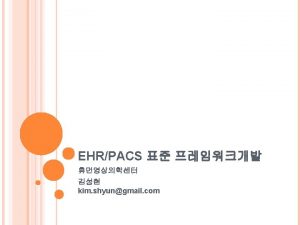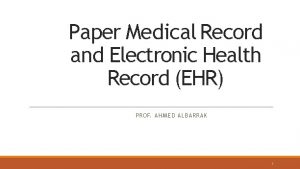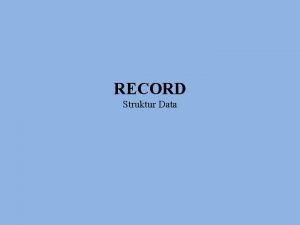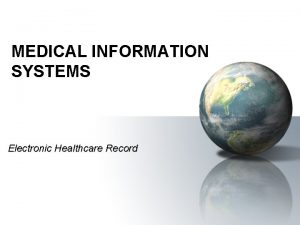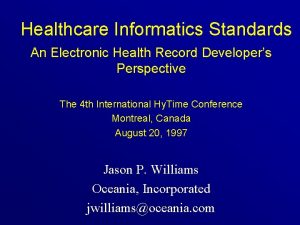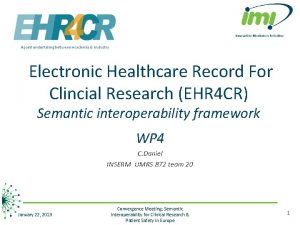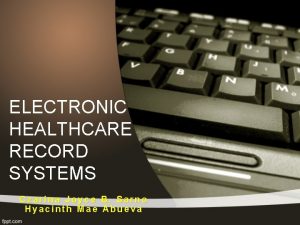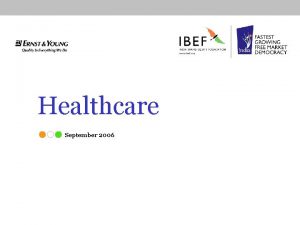Faithfulness of Electronic Healthcare Record Data a Shared



![Pubmed – [EHR] OR [EMR] count (January 3, 2019) 80 70 60 50 40 Pubmed – [EHR] OR [EMR] count (January 3, 2019) 80 70 60 50 40](https://slidetodoc.com/presentation_image_h2/9b2cf8fbee77a52cd672e0a1d00cf216/image-4.jpg)






![Pubmed – [EHR] OR [EMR] count (January 3, 2019) 80 70 60 50 40 Pubmed – [EHR] OR [EMR] count (January 3, 2019) 80 70 60 50 40](https://slidetodoc.com/presentation_image_h2/9b2cf8fbee77a52cd672e0a1d00cf216/image-11.jpg)
![Pubmed – [EHR] OR [EMR] count (January 3, 2019) 1800 1600 1400 1200 1000 Pubmed – [EHR] OR [EMR] count (January 3, 2019) 1800 1600 1400 1200 1000](https://slidetodoc.com/presentation_image_h2/9b2cf8fbee77a52cd672e0a1d00cf216/image-12.jpg)





















































































- Slides: 97

Faithfulness of Electronic Healthcare Record Data: a Shared Responsibility! Grand Round of the Department of Biomedical Informatics January 9, 2019 – Buffalo, NY, USA Werner CEUSTERS, MD Department of Biomedical Informatics, Division of Biomedical Ontology and UB Institute for Healthcare Informatics, University at Buffalo

Talk layout • • • Why this topic ? Why me? EHR Functionalities and expectations EHR-related morbidity Secondary use and data quality What now?

![Pubmed EHR OR EMR count January 3 2019 80 70 60 50 40 Pubmed – [EHR] OR [EMR] count (January 3, 2019) 80 70 60 50 40](https://slidetodoc.com/presentation_image_h2/9b2cf8fbee77a52cd672e0a1d00cf216/image-4.jpg)
Pubmed – [EHR] OR [EMR] count (January 3, 2019) 80 70 60 50 40 30 20 10 0 1940 1950 1960 1970 1980 1990 2000 2010

5 EHRs: attention to functionality (US) Billing Practice management Lab results e. Prescribing Regulations Clinical

6 EHRs: attention to functionality (US) W. Europe Billing Practice management Lab results e. Prescribing Regulations Clinical


1996


![Pubmed EHR OR EMR count January 3 2019 80 70 60 50 40 Pubmed – [EHR] OR [EMR] count (January 3, 2019) 80 70 60 50 40](https://slidetodoc.com/presentation_image_h2/9b2cf8fbee77a52cd672e0a1d00cf216/image-11.jpg)
Pubmed – [EHR] OR [EMR] count (January 3, 2019) 80 70 60 50 40 30 20 10 0 1940 1950 1960 1970 1980 1990 2000 2010
![Pubmed EHR OR EMR count January 3 2019 1800 1600 1400 1200 1000 Pubmed – [EHR] OR [EMR] count (January 3, 2019) 1800 1600 1400 1200 1000](https://slidetodoc.com/presentation_image_h2/9b2cf8fbee77a52cd672e0a1d00cf216/image-12.jpg)
Pubmed – [EHR] OR [EMR] count (January 3, 2019) 1800 1600 1400 1200 1000 800 600 400 200 0 1940 1950 1960 1970 1980 1990 2000 2010 2020 2030

Was I right?


Functionality and Effectiveness

https: //www. healthit. gov


True or wishful thinking?

Rank

Score

https: //www. pearsonhighered. com/content/dam/regionna/us/higher-ed/en/custom-product/gartee-electronic-healthrecords-3 e/pdf/gartee 3 e-ch 1. pdf

True or wishful thinking?

HEDIS® Quality Measures ▶A. Cancer Screening. ▶B. Diabetes Care. ▶C. Asthma Care. ▶D. Well Child and Adolescent Visit ▶E. Behavioral and Mental Health. ▶F. Women's Health.


EHR use and patient outcomes

EHR use and MI outcomes

EHR and chronic disease management

Systematic review of 13 studies • chronic disease patients benefit most by: • decision support tools that alert physicians of drug interactions, • communication tools that keep them informed and engaged in their treatment regimens and • detailed reporting and tracking designed to inform progress. • Collective results suggest that EHR technology is advancing rapidly; • however, patient outcomes documented via EHR systems remain largely unknown. Lessing SE 1, Hayman LL. Diabetes Care and Management Using Electronic Medical Records: A Systematic Review. J Diabetes Sci Technol. 2018 Dec 17.

Impact on ICUs

Ann Emerg Med. 2014 Jun; 63(6): 723 -30. doi: 10. 1016/j. annemergmed. 2013. 12. 019. Epub 2014 Jan 10. The effect of electronic health record implementation on community emergency departmentoperational measures of performance. 1 Ward MJ , Landman AB 2, Case K 3, Berthelot J 3, Pilgrim RL 3, Pines JM 4.

Ann Emerg Med. 2014 Jun; 63(6): 723 -30. doi: 10. 1016/j. annemergmed. 2013. 12. 019. Epub 2014 Jan 10. The effect of electronic health record implementation on community emergency departmentoperational measures of performance. 1 Ward MJ , Landman AB 2, Case K 3, Berthelot J 3, Pilgrim RL 3, Pines JM 4.

https: //www. softwareadvice. com /resources/ehr-software-buyertrends-2015/

Importance of optimization of EHR

Physician satisfaction with EHR

Physician dissatisfaction with EHR

% difference EHR use < or > 4 year

Reasons cited for not allowing students to document in the EHR. Reasons for not allowing student documentation (37% of 97 institutions, EM clerkship): 80% 60% 53% 38% 15% 11% Medical school or hospital rule forbidding student documentation Concern for medical liability Inability for student notes to support medical billing Lack of computer workspace/access No documentation educational objective for the clerkship Lack of ability to review notes and provide feedback

Reasons cited for not allowing students to document in the EHR. 95% EM clerkships reviewed student notes for feedback: Fewer than half of notes reviewed (70%) Half to three-quarters of notes reviewed (23%) Three quarters or more reviewed (7%) Feedback provided by faculty (92%) Feedback provided by clerkship director (40%) Feedback provided by residents (64%) Oral feedback only provided (75%) Oral and written feedback given (25%) Documentation considered in final grade (58%)




https: //www. softwareadvice. com/resources/ehr-software-buyer-trends-2015/







EHRs are good for you

5 3

5 4

A usability and safety analysis of electronic health records: a multi-center study. System feedback Suboptimal clinical decision support or error prevention No feedback to user about system actions Automation or conversion with no clear feedback Wrong feedback about system actions Visual display Suboptimal interface between applications Hard to find or confusing information display Wrong information displayed Alert difficult to interpret Data entry Confusing data entry (where to put info) Work-around needed Unable to enter desired information Workflow support Mismatch between mental model and actual system Lack of support for communication Suboptimal teamwork support 54 70. 8 7. 8 18 3. 4 28. 9 37. 1 34. 3 26. 4 2. 2 13 36. 5 27 4. 1 15 70 15 93. 5 97. 4 1 1. 4 0. 2 2. 9 7. 4 31. 5 59. 3 1. 8 2. 3 29. 6 22. 7 47. 7 1. 3 56 8 36 74. 5 91. 7 5. 6 0 2. 7 13. 8 49. 2 32 13. 1 5. 7 10. 6 59. 6 30. 9 9. 5 1. 1 40 20 40 82. 4 93. 6 2. 9 2. 4 1. 1 9. 7 36. 7 33 26. 8 3. 5 6. 2 45. 8 30. 8 23. 4 1. 7 38. 2 32. 7 29. 1 J Am Med Inform Assoc. 2018 Sep 1; 25(9): 1197 -1201. Ratwani RM 1, 2, Savage E 1, Will A 1, Arnold R 3, Khairat S 4, Miller K 1, Fairbanks RJ 1, 2, Hodgkins M 5, Hettinger AZ 1, 2.

5 6

5 7


Secondary use Issues of data quality

Tri. Net. X data confirm RCT results


W. R Hersh, M. G. Weiner, P. J. Embi, J. R. Logan, P. R. Payne, E. V. Bernstam, H. P. Lehmann, G. Hripcsak, T. H. Hartzog, J. J. Cimino, J. H. Saltz. Caveats for the use of operational electronic health record data in comparative effectiveness research, Medical care 51 (2013), 30 -37.

all observations made about a patient a preset number or frequency over time all desired types (for 2 ndary use) of data sufficient to predict a phenomenon of interest

Incidence and prevalence calculations for care planning

Possible Assumptions for Observable persontime in EHR Databases (OE) Clin Epidemiol. 2018 Dec 17; 11: 1 -15. Measuring prevalence and incidence of chronic conditions in claims and electronic health recorddatabases. Rassen JA 1, Bartels DB 2, Schneeweiss S 1, 3, 4, Patrick AR 1, Murk W 1, 5.

Design choices for incidence Incidence numerator (N/A) Cumulative At-risk, Day 1 incidence population denominator The number of patients who did have the disease observed in the POI, were at risk for onset of disease, and did not have disease observed in the lookback time. The number of patients who were at risk for onset of disease and who contributed an observable person-day on the first day of the POI. At-risk, complete- The number of patients who were at risk for onset of disease period population and who contributed all possible observable person-days within the POI. At-risk, any-time The number of patients who were at risk for onset of disease population and who contributed all ≥ 1 person-days within the POI. At-risk sufficient- The number of patients who were at risk for onset of disease time population and who contributed at least “n” observable person-days within the POI; n≥ 1. Incidence rate Person-time at risk The amount of observable person-time in the POI at risk for denominator onset of disease. Clin Epidemiol. 2018 Dec 17; 11: 1 -15. Measuring prevalence and incidence of chronic conditions in claims and electronic health recorddatabases. Rassen JA 1, Bartels DB 2, Schneeweiss S 1, 3, 4, Patrick AR 1, Murk W 1, 5.

Incidence/prevalence design choices from EHR - data • Observability: 3 • Lookback time: 2 • Lookback-observability requirement: 2 • Numerator • Denominator • Combined • Prevalence 2 4 96 Incidence 1 (cumulative: 4!) 1 12 (48) Clin Epidemiol. 2018 Dec 17; 11: 1 -15. Measuring prevalence and incidence of chronic conditions in claims and electronic health recorddatabases. Rassen JA 1, Bartels DB 2, Schneeweiss S 1, 3, 4, Patrick AR 1, Murk W 1, 5.

Effects of different look-back choices Clin Epidemiol. 2018 Dec 17; 11: 1 -15. Measuring prevalence and incidence of chronic conditions in claims and electronic health recorddatabases. Rassen JA 1, Bartels DB 2, Schneeweiss S 1, 3, 4, Patrick AR 1, Murk W 1, 5.



NDF NDF

Feasibility of real-time capture of routine clinical data in the electronic health record: a hospital-based, observational service-evaluation study. • Used Cerner’s Power. Chart application to develop a SNOMEDbased electronic Power. Form comprising a user-friendly interface for real-time entry of clinical data during consultation. • Power. Forms were used in 360 (61%) of these patients, the rate increasing from 42% in June 2016 to 77% in January 2017. • The average consultation time, measured in the substudy of 44 patients, was 13. 97± 3. 5 min using the Power. Form (n=22) compared with 14. 22± 2. 95 min using conventional paper documentation (n=22). BMJ Open. 2018 Mar 8; 8(3): e 019790. Bodagh N 1, Archbold RA 1, Weerackody R 1, Hawking MKD 2, Barnes MR 3, Lee AM 4, Janjuha S 1, Gutteridge C 1, Robson J 2, Timmis A 1, 5.

Clinical Reasoning Documentation

Findings despite few studies (n=23) • 4 key themes: purposes of electronic clinical notes, • clinicians' reasoning for note-entry and reading/retrieval, • clinicians' strategies for note-entry, • and clinicians' strategies for note-retrieval/reading. • • Findings: although patient care is the primary note purpose, non-clinical purposes have become more common, • what clinicians document is affected by EHR interfaces, • "assessment and plan" is the most read note section, • what clinicians read is affected by external stimuli, care/information goals, and what they know about the patient. • Colicchio TK 1, Cimino JJ 1. Clinicians' reasoning as reflected in electronic clinical note-entry and reading/retrieval: a systematic review and qualitative synthesis. J Am Med Inform Assoc. 2018 Dec 20.

Digging in our own data


Data aggregation and use Operational systems EHR EHR Bio Bank Health Insurers IHI Clinical Integrated Data Repository Data Marts Secondary use Cohort selection Cost effectiveness research Decision support Quality assurance

Data aggregation and use Operational systems EHR EHR Bio Bank Health Insurers IHI Clinical Integrated Data Repository Data Marts Common Data Models Secondary use Cohort selection Cost effectiveness research Decision support Quality assurance

Common Data Models for Secondary Use • The Observational Medical Outcomes Partnership (OMOP) • Health Care Systems Research Network (HCSRN) • The National Patient-Centered Clinical Research Network (PCORNet)

CDMs introduce mistakes • Blaisure J, Ceusters W. Business Rules to Improve Secondary Data Use of Electronic Healthcare Systems. Informatics for Health 2017, Manchester Central, UK, April 24 -26, 2017. Stud Health Technol Inform. 2017; 235: 303 -307. • Ceusters W, Blaisure J. A Realism-Based View on Counts in OMOP’s Common Data Model. 14 th International Conference on Wearable, micro & Nano Technologies (p. Health 2017), Eindhoven, The Netherlands, May 14 -16, 2017. Studies in Health Technology and Informatics 2017; 237: 55 -62. • Blaisure J, Ceusters W. Improving the Fitness for Purpose of Common Data Models through Realism Based Ontology. AMIA 2017 Annual Symposium, Washington DC, Nov 04 -08, 2017. AMIA Annu Symp Proc. 2017; 2017: 440– 447.

Data aggregation and use Operational systems EHR EHR Bio Bank Health Insurers IHI Clinical Integrated Data Repository Data Marts Common Data Models Realist Ontology (RO) & Referent Tracking (RT)based Data Repository Secondary use Cohort selection Cost effectiveness research Decision support Quality assurance

Research question • Can these principles be applied to assess the extent to which the transactions registered in the EHR’s database resulting from managing the problem list provide insight in: 1. the adequacy of the clinical user interface to capture 2. what the clinician had in mind, with the goal 3. to reconstruct the clinical reality of the patient? Ceusters W, Blaisure J. Caveats for the use of the active problem list as ground truth for decision support. EFMI Special Topic Conference on Decision Support Systems and Education (EFMI STC-2018), Zagreb, Kroatia, Oct 14 -16, 2018. Stud Health Technol Inform. 2018; 255: 10 -14.

https: //www. cms. gov/Regulations-and-Guidance/Legislation/EHRIncentive. Programs/downloads/3_Maintain_Problem_List. EP. pdf

L. Weed. Medical records that guide and teach. New England Journal of Medicine 278 (1968), 593 -600.




Problems Encounters Episodes Salmon P, Rappaport A, Bainbridge M, Hayes G, Williams J. Taking the problem oriented medical record forward. Proc AMIA Annu Fall Symp. 1996: 463 -7.

Methodology Problem Type Problem Header Transition Problem Category Problem Status Problem Instance Encounter ~6, 000, 000 Patient ~500, 000 Problem Header Change Record

Results Problem Type Problem Header ~370, 000 Transition ~23, 000 Problem Status Problem Category Problem Instance Encounter ~6, 000 ~765, 000 Patient ~500, 000 ~80, 000 Problem Header Change Record ~395, 000 rec. / ~664, 000 ch.

Change count distributions Changes Frequency Cumulative % Transitions Frequency % 1 349, 361 94. 52% 1 21819 94. 202% 2 16, 325 98. 94% 2 1154 4. 982% 3 3, 426 99. 86% 3 150 0. 648% 4 312 99. 95% 4 34 0. 147% 5 147 99. 99% 5 4 0. 017% 6 14 99. 99% 6 1 0. 004% 7 to 34 26 100. 00% Ceusters W, Blaisure J. Caveats for the use of the active problem list as ground truth for decision support. EFMI Special Topic Conference on Decision Support Systems and Education (EFMI STC-2018), Zagreb, Kroatia, Oct 14 -16, 2018. Stud Health Technol Inform. 2018; 255: 10 -14.

Problem status changes Ceusters W, Blaisure J. Caveats for the use of the active problem list as ground truth for decision support. EFMI Special Topic Conference on Decision Support Systems and Education (EFMI STC-2018), Zagreb, Kroatia, Oct 14 -16, 2018. Stud Health Technol Inform. 2018; 255: 10 -14.

Active / Resolved EHR update event Pt. ID Problem B 1 0 1 2 3 4 5 6 7 8 9 10 11 12 13 14 15 1 Cerumen Impaction In Both Ears N D D DDD R A 2 Impacted cerumen of right ear B 2 1 Cerumen Impaction N D R A R A D D C 1 1 Acute Sinusitis N DD R A C 2 1 Acute Sinusitis N DD D DDR A D D R A D N Legend: ‘Pt. ID’: patient identifier; ‘Pr. ID’: problem header identifier; ‘N’: Problem header added and marked active; ‘D’: problem documentation added; ‘A’: problem header marked active; ‘R’: problem resolved; Arrow: problem ‘transitioned’ into the problem pointed at by the arrow. Solid background: problem ‘active’.

Transitions in two diabetes patients Ceusters W, Blaisure J. Caveats for the use of the active problem list as ground truth for decision support. EFMI Special Topic Conference on Decision Support Systems and Education (EFMI STC-2018), Zagreb, Kroatia, Oct 14 -16, 2018. Stud Health Technol Inform. 2018; 255: 10 -14.

Note: 1 A and 1 B any time: 650 patients


Future work: towards an OGMS-based Referent Tracking Interpretation

Conclusions of this analysis 1. Poor reality / representation correspondence: 1. Impossible co-morbidity assertions; 2. Resolved disorders appear again: 1. ‘problem’ as type rather than particular, or, 2. ‘problem’ as assertion rather than first-order entity; Use of ‘inactive’ poorly related to presence or absence of disease entity. 2. User-interface itself is conducive to reality and representation confusion. 3. Secondary use for knowledge acquisition and decision report requires much caution. 3. Ceusters W, Blaisure J. Caveats for the use of the active problem list as ground truth for decision support. EFMI Special Topic Conference on Decision Support Systems and Education (EFMI STC-2018), Zagreb, Kroatia, Oct 14 -16, 2018. Stud Health Technol Inform. 2018; 255: 10 -14.

Wish list for BMI?

 Simple shared healthcare
Simple shared healthcare Healthcare and the healthcare team chapter 2
Healthcare and the healthcare team chapter 2 Sports medicine definition
Sports medicine definition Specimen record observation
Specimen record observation Next generation emr
Next generation emr Integrated electronic medical record
Integrated electronic medical record How to convert paper br to electronic batch record
How to convert paper br to electronic batch record Electronic health record modernization services
Electronic health record modernization services Faithful translation example
Faithful translation example Hymn 100 sda
Hymn 100 sda Great is thy faithfulness 中文
Great is thy faithfulness 中文 Besides faithfulness to god what is the strongest value
Besides faithfulness to god what is the strongest value Thomas obadiah chisholm
Thomas obadiah chisholm Thomas obadiah chisholm great is thy faithfulness lyrics
Thomas obadiah chisholm great is thy faithfulness lyrics Types of faithfulness
Types of faithfulness Great is thy faithfulness 中文
Great is thy faithfulness 中文 Great is thy faithfulness 中文
Great is thy faithfulness 中文 Great is thu faithfulness
Great is thu faithfulness Brand loyalty synonym
Brand loyalty synonym Great is thy faithfulness 中文
Great is thy faithfulness 中文 Steve jobs adversity
Steve jobs adversity Great is thy faithfulness oh god my father
Great is thy faithfulness oh god my father Faithfulness in adversity
Faithfulness in adversity Great is your faithfulness oh god
Great is your faithfulness oh god Is the electronic exchange of money or scrip
Is the electronic exchange of money or scrip Electronic field production
Electronic field production It provides a common framework to allow data to be shared
It provides a common framework to allow data to be shared Interrupts in embedded system
Interrupts in embedded system Shared data model
Shared data model Secondary uses of healthcare data
Secondary uses of healthcare data Late binding data warehouse
Late binding data warehouse Medical internet of things and big data in healthcare
Medical internet of things and big data in healthcare Jenis data kesehatan
Jenis data kesehatan Oracle healthcare data model
Oracle healthcare data model Healthcare data extraction
Healthcare data extraction Introduction to healthcare data analytics
Introduction to healthcare data analytics Healthcare data standards
Healthcare data standards Predictive prescriptive analytics
Predictive prescriptive analytics Demystifying healthcare data governance
Demystifying healthcare data governance Active record vs data mapper
Active record vs data mapper Active record vs data mapper
Active record vs data mapper Simbol garis atau line pada er model menunjukkan ....
Simbol garis atau line pada er model menunjukkan .... Philip c. ritchey
Philip c. ritchey Yang merupakan pengertian dari rekaman data adalah ?..
Yang merupakan pengertian dari rekaman data adalah ?.. Perintah input dbase
Perintah input dbase Object-based data model
Object-based data model Electronic data sheets
Electronic data sheets Herds reporting
Herds reporting Edi trends
Edi trends Electronic data capture rave
Electronic data capture rave Electronic data interchange
Electronic data interchange A programmable electronic device designed to accept data
A programmable electronic device designed to accept data Electronic data interchange
Electronic data interchange Electronic dental data exchange
Electronic dental data exchange Edi exchange
Edi exchange Define edi in e commerce
Define edi in e commerce Electronic data capture process flow
Electronic data capture process flow Shared inquiry definition
Shared inquiry definition Shared reading vs read aloud
Shared reading vs read aloud It shared service center
It shared service center Powervm shared storage pools
Powervm shared storage pools Posix shared memory synchronization
Posix shared memory synchronization Vccs ssc
Vccs ssc Shared management model
Shared management model Shared inquiry
Shared inquiry Core practice model
Core practice model Shared knowledge
Shared knowledge It shared services examples
It shared services examples Hhhlh
Hhhlh Hrweb resa
Hrweb resa Shared responsibility approach
Shared responsibility approach Google translate english to french
Google translate english to french Shared vs distributed memory
Shared vs distributed memory Distributed shared memory architecture tutorialspoint
Distributed shared memory architecture tutorialspoint Shared investigator platform login
Shared investigator platform login Model hoy
Model hoy Section 38-1 review echinoderms answer key
Section 38-1 review echinoderms answer key Broken yellow center line
Broken yellow center line Shared reading vs read aloud
Shared reading vs read aloud Shared memory in java
Shared memory in java Procurement shared services model
Procurement shared services model Jerome kevin and seth shared a submarine sandwich
Jerome kevin and seth shared a submarine sandwich Hr shared services model
Hr shared services model Personal and shared knowledge
Personal and shared knowledge Shared services value proposition
Shared services value proposition Autoscopic psychosis
Autoscopic psychosis Is a shared system of meaning among employees
Is a shared system of meaning among employees Nasa shared services center
Nasa shared services center Nasa shared service center
Nasa shared service center Share a single centralized memory
Share a single centralized memory Knowledge shared is knowledge squared meaning
Knowledge shared is knowledge squared meaning Knowledge shared is knowledge multiplied interpretation
Knowledge shared is knowledge multiplied interpretation Shared situational awareness jesip
Shared situational awareness jesip Message passing os
Message passing os Shared reading vs read aloud
Shared reading vs read aloud Jhu hr shared services
Jhu hr shared services Definition of guided reading
Definition of guided reading Shared reading vs read aloud
Shared reading vs read aloud

